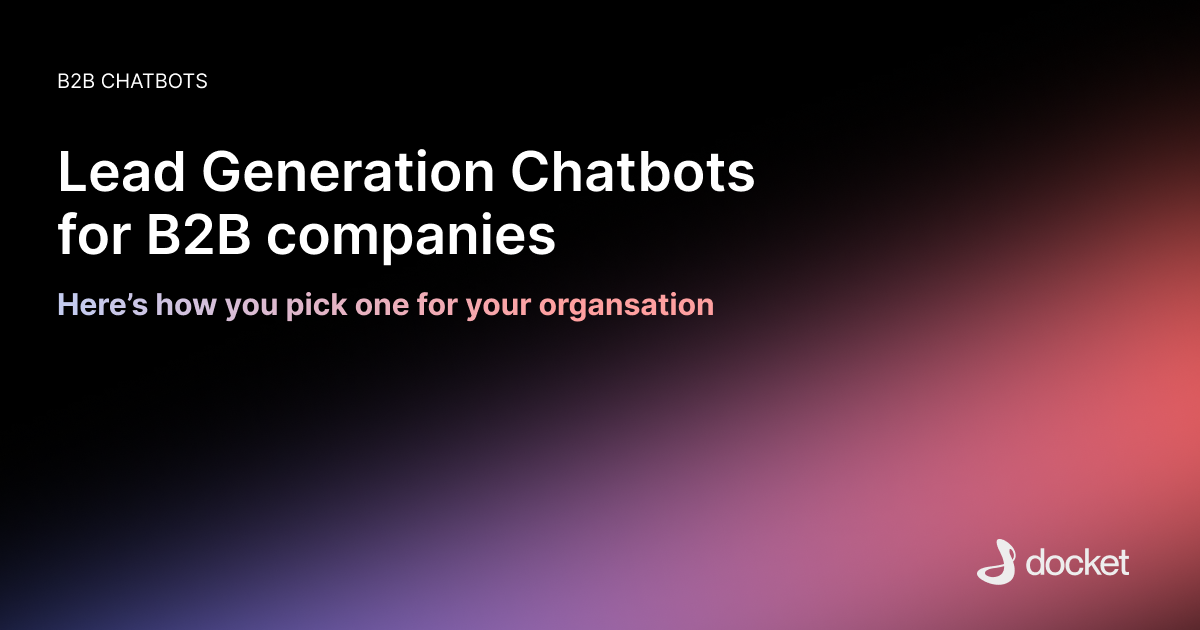Over 98% of B2B website visitors browse and bounce without taking action, even when they desperately need a solution like yours.
Your website generates traffic, your content resonates & your value prop is solid.
But somewhere between "I need this" and "Let me book a demo," half your pipeline vanishes into the digital void.
The problem lies in static, rule-based chatbots, which were intended to solve this exact issue.
Or the lack of chatbots that can have human-like conversations to start with.
In this post, we’ll explain why traditional chatbots kill all your momentum and how AI-based chatbots are built differently.
Today: The chatbot graveyard
Most B2B websites deploy chatbots that follow rigid decision trees. A prospect lands on your pricing page at 11 PM, has a specific integration question, and gets greeted with:
"Hi! I'm Lenny the ChatBot. Would you like to: A) Download our case study, B) Book a demo, or C) Talk to sales?"
The prospect thinks: "I just need to know if you integrate with Salesforce."
But your bot can't handle that.
It doesn't understand context.
It can't provide nuanced answers.
It certainly can't have a real conversation.
Result: A majority of your website visitors abandon the chat within the first interaction
A faster alternative is adding something like Docket’s Marketing Agent that answers context-specific questions with visuals and keeps the chat going instead of dead-ending. We’ll explain more on this in the later sections of the blog.
Here’s an explainer video if you are curious about what our marketing agent does 👇🏻
Tomorrow: Context meets conversion
Autonomous AI agents understand intent, provide detailed answers, and guide prospects through personalized journeys in real-time.
When that same prospect asks about Salesforce integration at 11 PM, an AI agent responds:
"Yes, we integrate directly with Salesforce. I can show you exactly how lead data flows from our platform to your CRM, including custom field mapping. Based on your company size, here's what the setup looks like..."
Then it qualifies them, addresses objections, and books a meeting - all while you sleep.
The Shift: From rigid scripts to intelligent conversations that convert.
If speed-to-response is your most significant gap, start here.
Which Lead-Gen chatbot should you trust?
The chatbot market is crowded, confusing, and full of solutions that promise the moon but deliver static decision trees. We’ve deciphered what the leading platforms offer based on current G2 reviews and user feedback:
1. Drift (G2 Rating: 4.2/5)
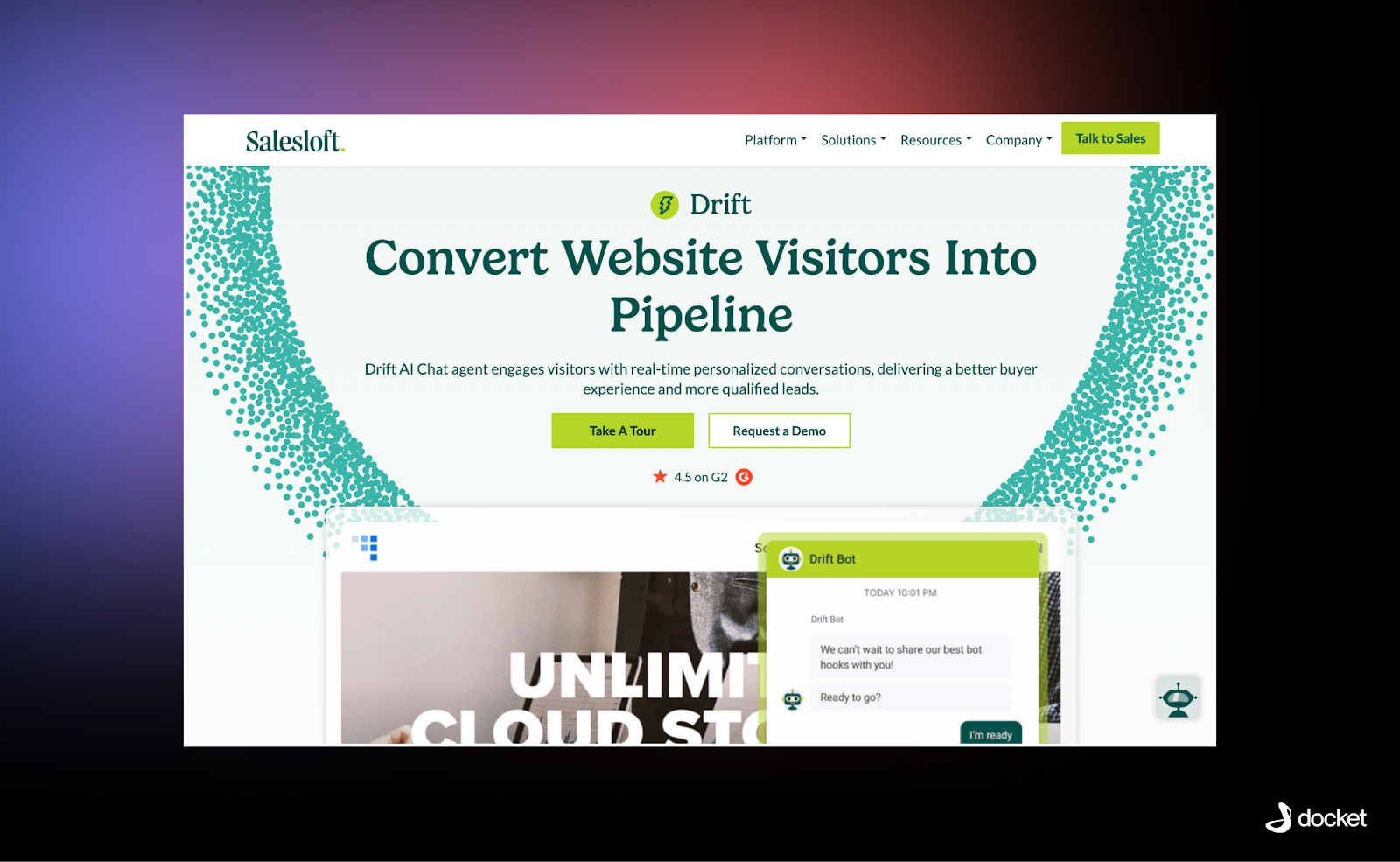
Approach: Rule-based conversational marketing playbooks
Pros:
- Pioneer in website chat widgets with strong brand recognition
- Good integration with marketing automation platforms
- Decent lead routing capabilities for basic qualification
- User-friendly interface for setting up simple chat flows
Cons:
- Limited by pre-programmed decision trees that can't adapt to context
- Restricted chat paths that frustrate users when they have specific questions
- Expensive pricing that doesn't align with actual conversion outcomes
- Poor handling of complex product questions outside predefined scripts
2. Intercom (G2 Rating: 4.5/5)
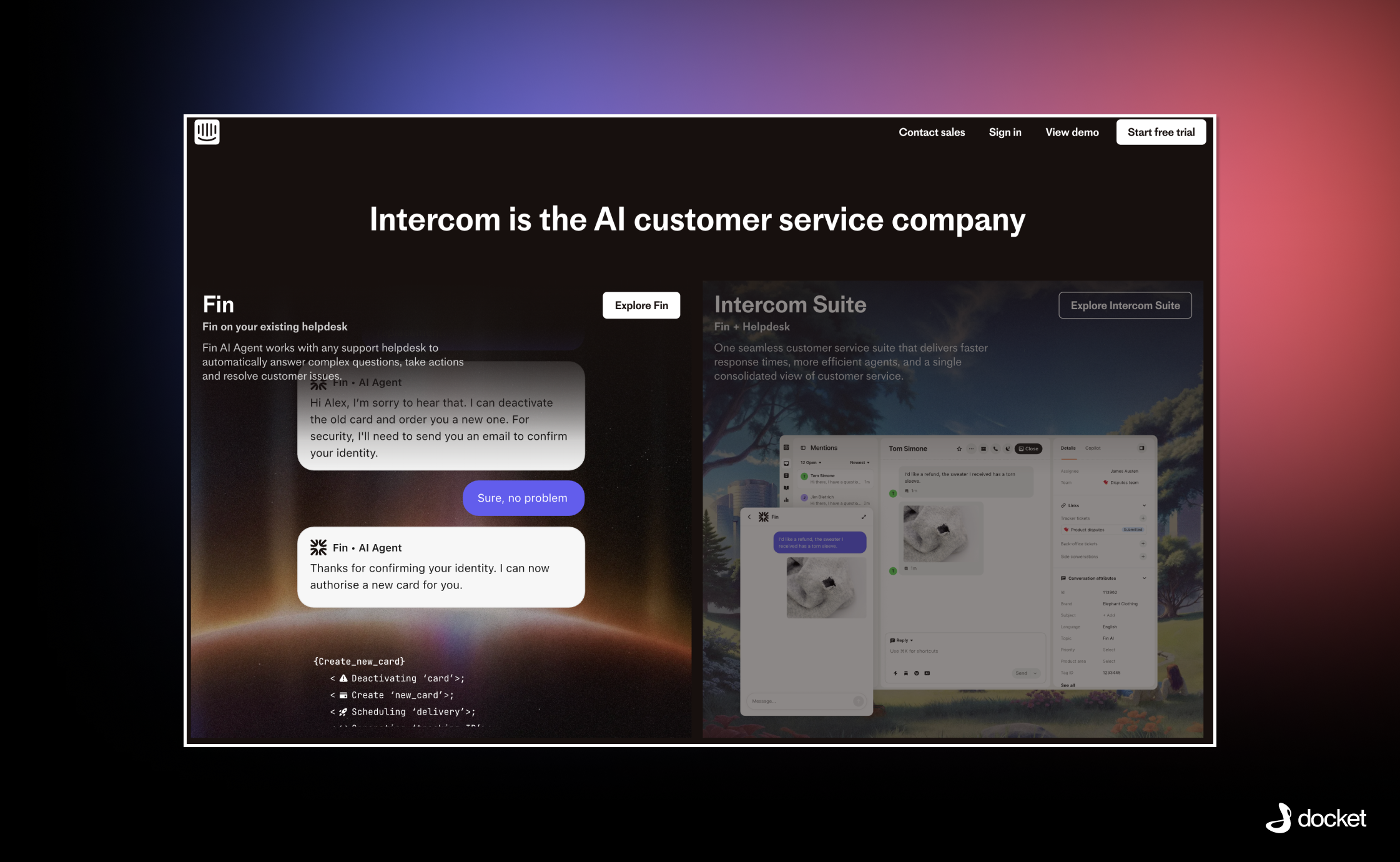
Approach: AI-powered automation with human handoff focus
Pros:
- Strong AI-powered chatbot that maintains a human-like tone and automates responses
- Excellent analytics tools for tracking customer behavior and patterns
- Robust help center functionality for self-service support
- Advanced customer segmentation capabilities for targeted messaging
Cons:
- Occasional lags and glitches, particularly during peak hours
- Limited customization options for help center branding
- Mixed reviews on live customer service response times
- Complex setup for custom properties and workflow automation
Biggest con - Not built to improve sales or pipeline.
3. HubSpot Service Hub (G2 Rating: 4.3/5)
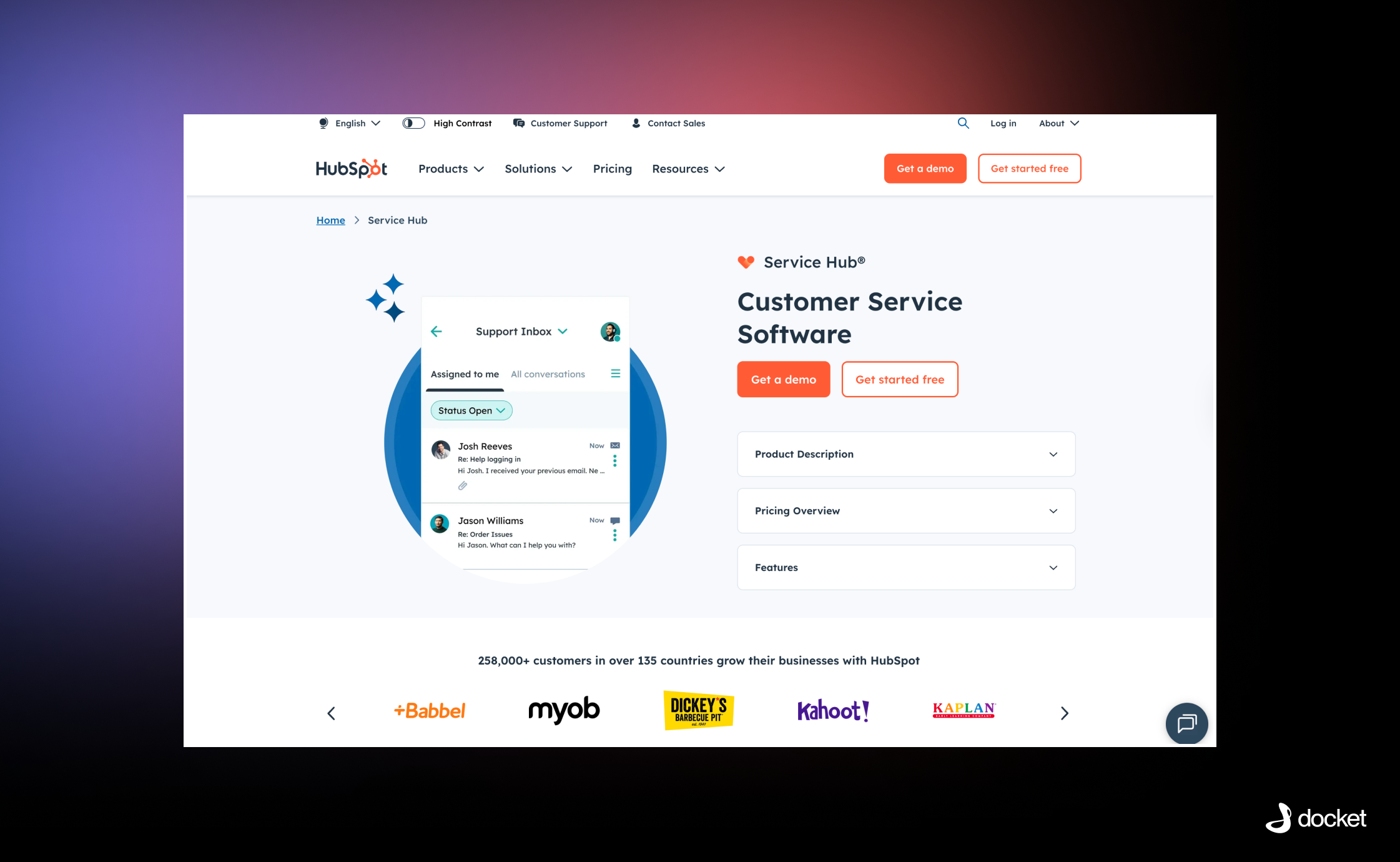
Approach: CRM-integrated support and chat flows
Pros:
- Efficient email-to-ticket conversion with automated tracking
- Everything integrated in one platform (ticketing, chat, analytics)
- Strong reporting dashboards for monitoring key metrics
- New Breeze Customer Agent offers improved personalization
Cons:
- Lacks advanced AI features and broad language support compared to newer AI-first tools
- Limited advanced customization for complex automation needs
- Search functionality feels dated and makes finding information difficult
- Occasional downtime that interrupts workflows
4. Qualified (G2 Rating: 4.1/5)
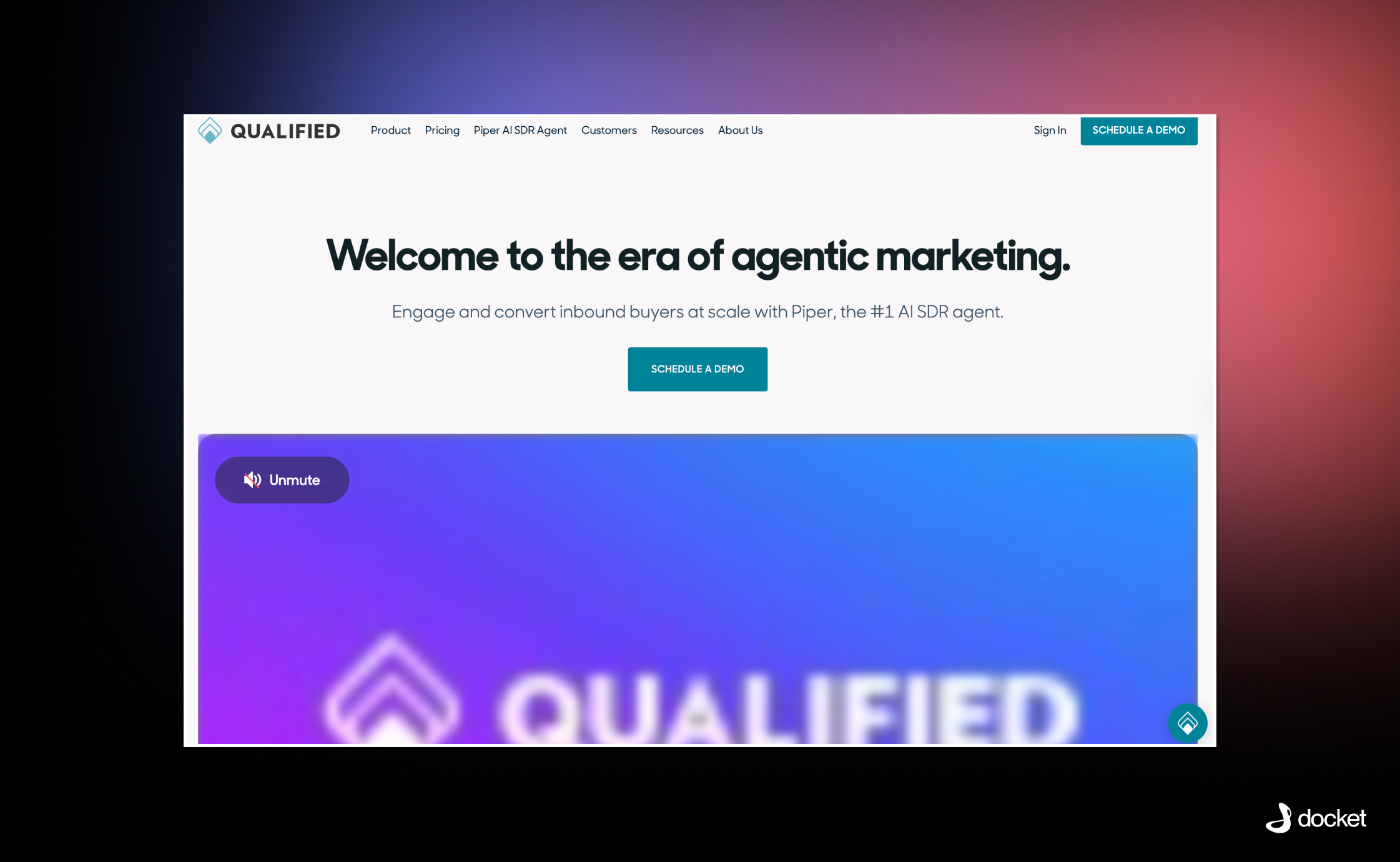
Approach: AI-powered conversation routing to human SDRs
Pros:
- Excellent at triggering chats based on user behavior and engagement timing
- Highly personalized chat flows based on visitor data and company information
- Real-time visitor context provided to sales teams before chat begins
- Built-in meeting scheduling to convert conversations into next steps
Cons:
- Still requires human SDRs to be online and available for handoffs
- Complex setup for advanced workflows, especially for non-technical users
- Limited customization for particular use cases
- Expensive pricing packages are not aligned with usage or outcomes.
5. Zendesk Support Suite (G2 Rating: 4.3/5)
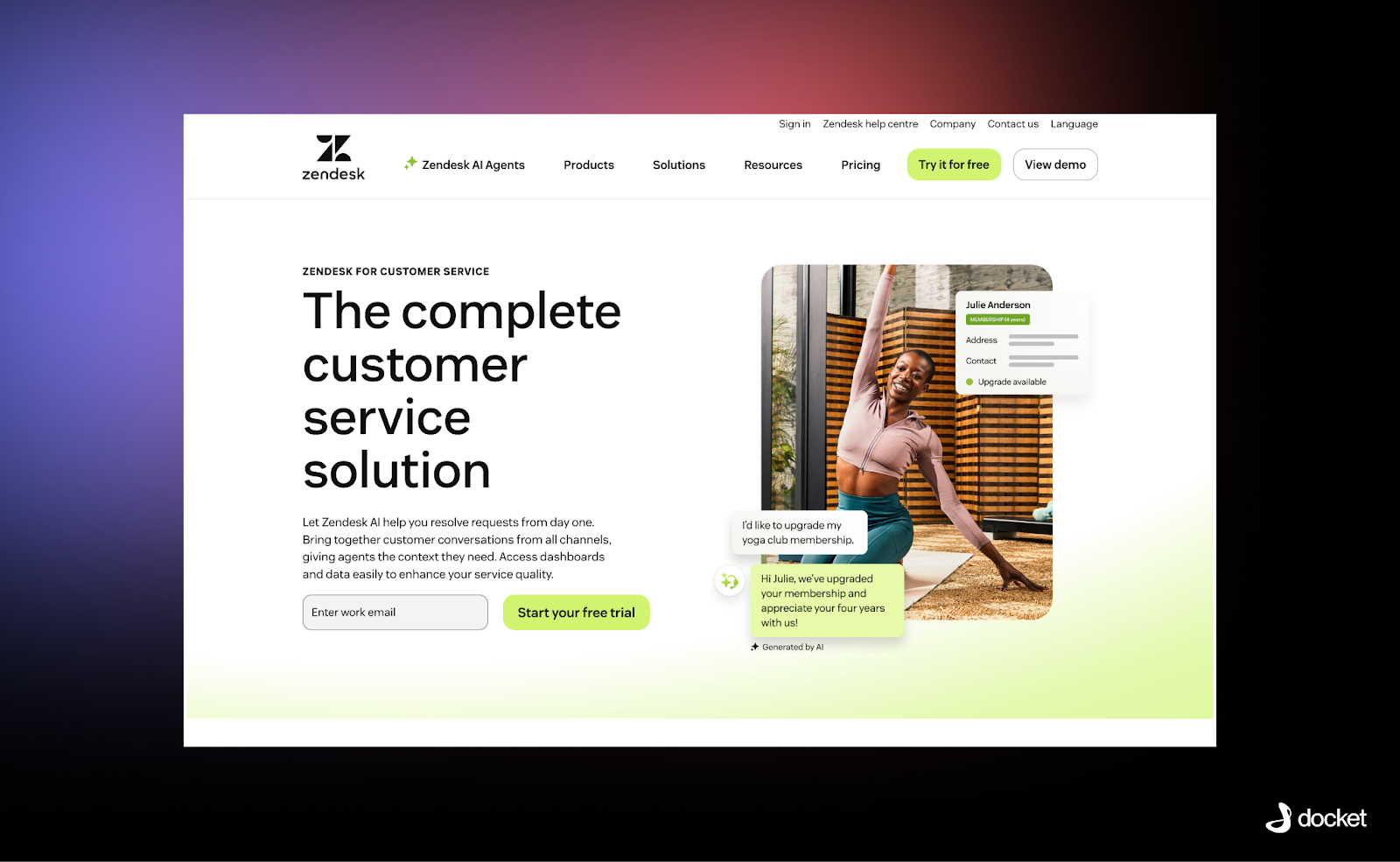
Approach: Support-focused ticketing with chat integration
Pros:
- Strong real-time communication capabilities with proactive engagement features
- Multilingual support for serving global audiences
- Smart chat routing based on predefined rules and specializations
- Customizable chat widget to match brand look and feel
Cons:
- Delayed notifications for incoming chats leading to missed opportunities
- Limited offline chat experience with minimal customization options
- No built-in video or voice call integration requiring external tools
- Primarily built for support, not lead generation and qualification
6. Tidio (G2 Rating: 4.5/5)
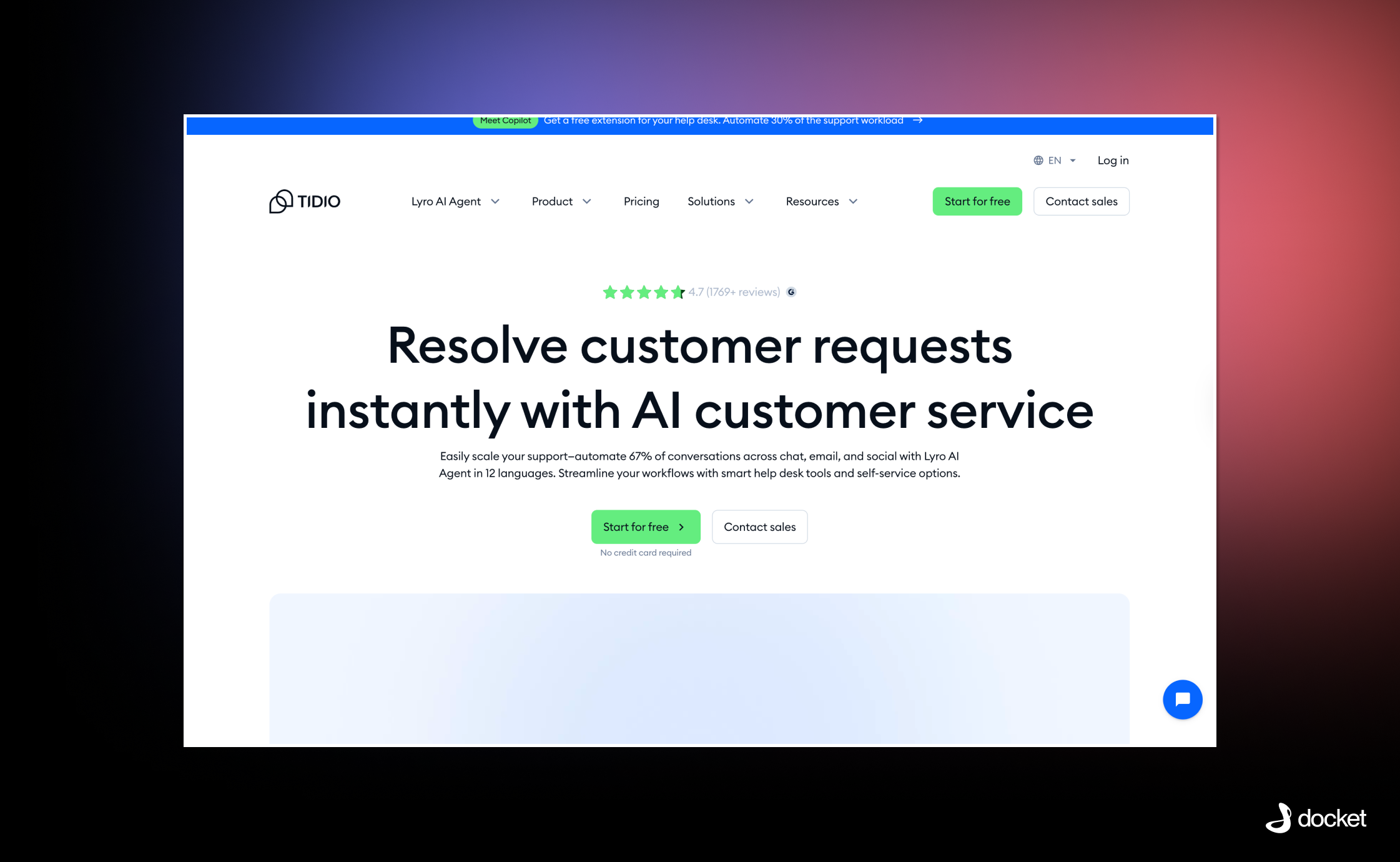
Approach: Basic chatbot builder with e-commerce focus
Pros:
- Highly rated for ease of setup and automation capabilities
- Affordable pricing structure suitable for small businesses
- Good integration with e-commerce platforms
- Simple visual chatbot builder requiring minimal technical knowledge
Cons:
- Limited intelligence for handling complex B2B sales conversations
- Basic analytics and reporting compared to enterprise solutions
- Lacks advanced qualification and routing capabilities
- Not designed for sophisticated lead scoring or sales processes
7. LiveChat (G2 Rating: 4.7/5)
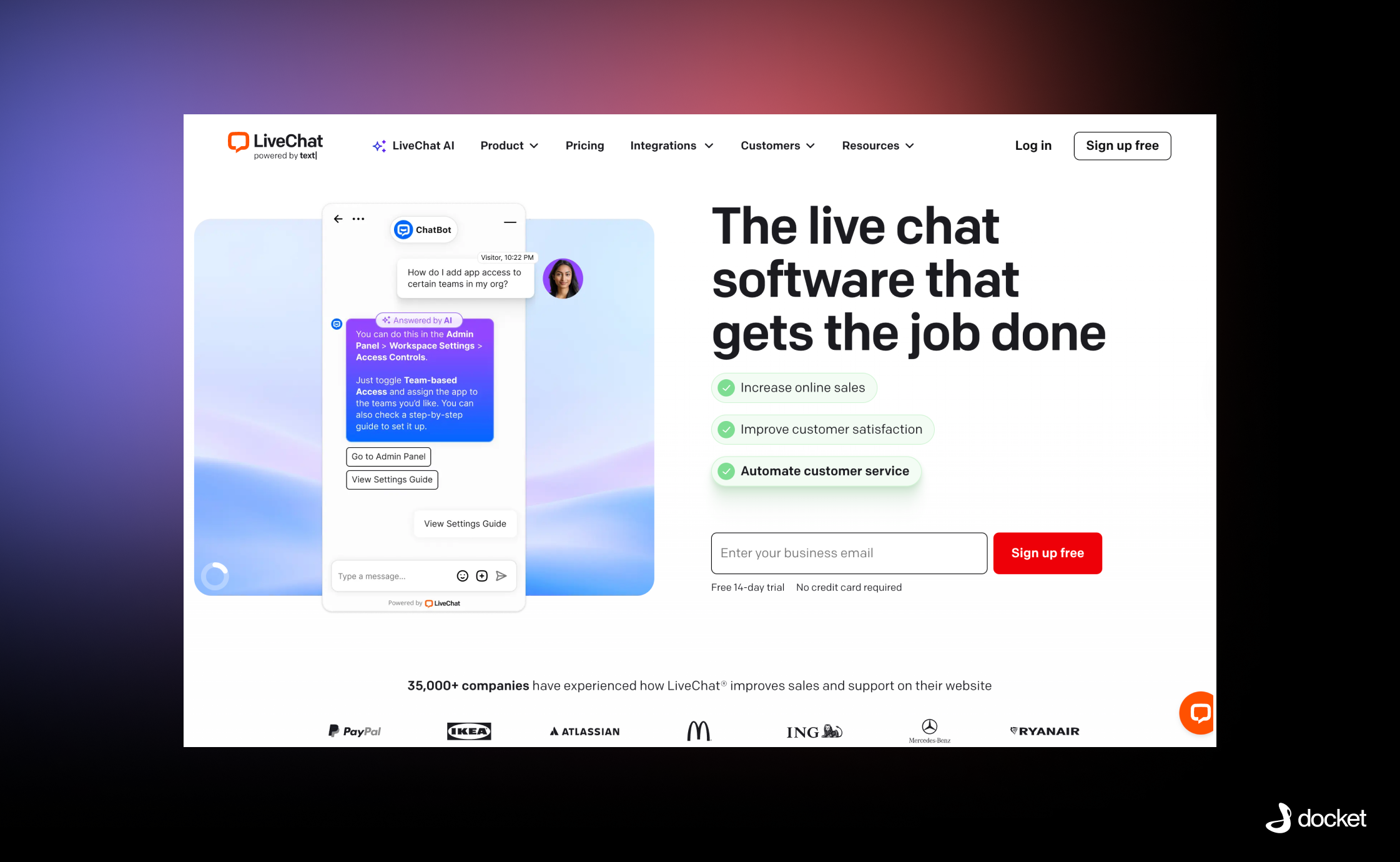
Approach: Human-first live support with basic automation
Pros:
- Excellent real-time human interaction capabilities
- Strong customer satisfaction scores for live support quality
- Good mobile app functionality for agents on the go
- Reliable uptime and performance during high-traffic periods
Cons:
- Defeats the purpose of automation by requiring constant human presence
- Limited AI capabilities for handling common questions autonomously
- Higher operational costs due to staffing requirements
- Not suitable for 24/7 availability without significant human resources
8. Crisp (G2 Rating: 4.4/5)

Approach: Multi-channel messaging with unified inbox
Pros:
- Strong unified inbox for managing multiple communication channels
- Good integration with social media and messaging platforms
- Clean, modern interface that's easy for agents to navigate
- Reasonable pricing for multi-channel capabilities
Cons:
- Weak lead qualification and scoring capabilities
- Limited automation features for complex sales processes
- Basic reporting and analytics compared to specialized sales tools
- Not optimized for B2B lead generation workflows
The fundamental problem is that every solution above either requires constant human intervention, follows rigid pre-programmed scripts, or lacks the autonomous intelligence to handle substantive B2B sales conversations while maintaining brand standards and delivering a truly qualified pipeline.
Unlike “conversation routers,” Docket’s Sales Knowledge Lake™ gives the agent actual product depth so that it can handle technical queries, competitive comps, and pricing nuances like a human expert.
The Autonomous-Agent approach
Autonomous AI agents represent a fundamental shift from reactive chatbots to proactive conversational experts. This section explains how this shift will play out.
Today: Chatbots react
Traditional chatbots wait for visitors to click predetermined options. They're reactive systems that follow scripts.
Tomorrow: Agents engage
Autonomous AI agents observe visitor behavior, understand context, and take intelligent action toward business goals.
Here's what makes them different:
1. Contextual Intelligence
- Understands visitor intent from page visits, referral source, and company profile
- Provides detailed, personalized responses using comprehensive product knowledge
- Adapts conversation style based on buyer persona and journey stage
2. Real-Time Qualification
- Asks discovery questions organically during conversation
- Scores leads based on fit, intent, and urgency
- Routes qualified prospects to the right sales team member
3. Autonomous Action
- Books meetings directly in sales calendars
- Updates CRM records with conversation insights
- Triggers personalized follow-up sequences
4. Continuous Learning
- Analyzes conversation patterns to improve responses
- Identifies knowledge gaps and content opportunities
- Optimizes qualification criteria based on closed-won patterns
Agentic chatbots will transition from following scripts to autonomously pursuing outcomes.
Modernise your lead-gen flow in 4 steps
Transforming your website from a lead-losing machine to a pipeline-generating engine doesn't require a complete overhaul. Here's how to do it systematically:
Step 1: Map your high-intent pages
Identify where your best prospects spend time before converting.
Action items:
- Audit pages with highest traffic but lowest conversion rates
- Identify content gaps where prospects typically drop off
- Map common questions your sales team fields repeatedly
Pro tip: Focus on pricing pages, product comparison pages, and case study sections first. These indicate high buyer intent.
Step 2: Centralise your knowledge base
Your AI agent needs comprehensive, up-to-date information to provide valuable responses.
Create a unified knowledge repository:
- Product documentation and feature descriptions
- Competitive comparison data
- Pricing information and package details
- Integration capabilities and technical requirements
- Case studies and success stories
- Common objection handling responses
Integration sources:
- CRM data for account context
- Support tickets for common questions
- Sales enablement materials
- Marketing content and collateral
- Slack threads that have answers from SMEs
This playbook shows how to build (and maintain) a sales knowledge lake backbone that agents can trust. Here’s another playbook on how to capture and share tribal knowledge so your agent stops guessing.
Step 3: Deploy your autonomous agent
Install an AI agent capable of handling substantive sales conversations, rather than just routing messages.
Key capabilities to evaluate:
- Natural language understanding for complex questions
- Dynamic response generation with supporting visuals
- Real-time lead scoring and qualification
- Calendar integration for meeting booking
- CRM synchronization for data capture
Implementation timeline: Best-in-class solutions like Docket deploy in 1-2 weeks with full integration.
Step 4: Iterate based on intent data
Use conversation analytics to improve your agent's performance continuously.
Monthly optimization routine:
- Review conversation transcripts for knowledge gaps
- Analyze qualification accuracy vs. closed-won rates
- Update response frameworks based on market changes
- Refine routing rules for better sales handoffs
Key metrics to track:
- Conversation engagement rate
- Qualification accuracy
- Meeting booking rate
- Pipeline contribution
What can an AI Chatbot do to your funnel?
Autonomous AI agents don't just improve chat metrics; they transform your entire go-to-market engine. Here’s an example of our marketing agent converting a non-ICP lead into one of our biggest ACV deals just by conversing with him like a human.
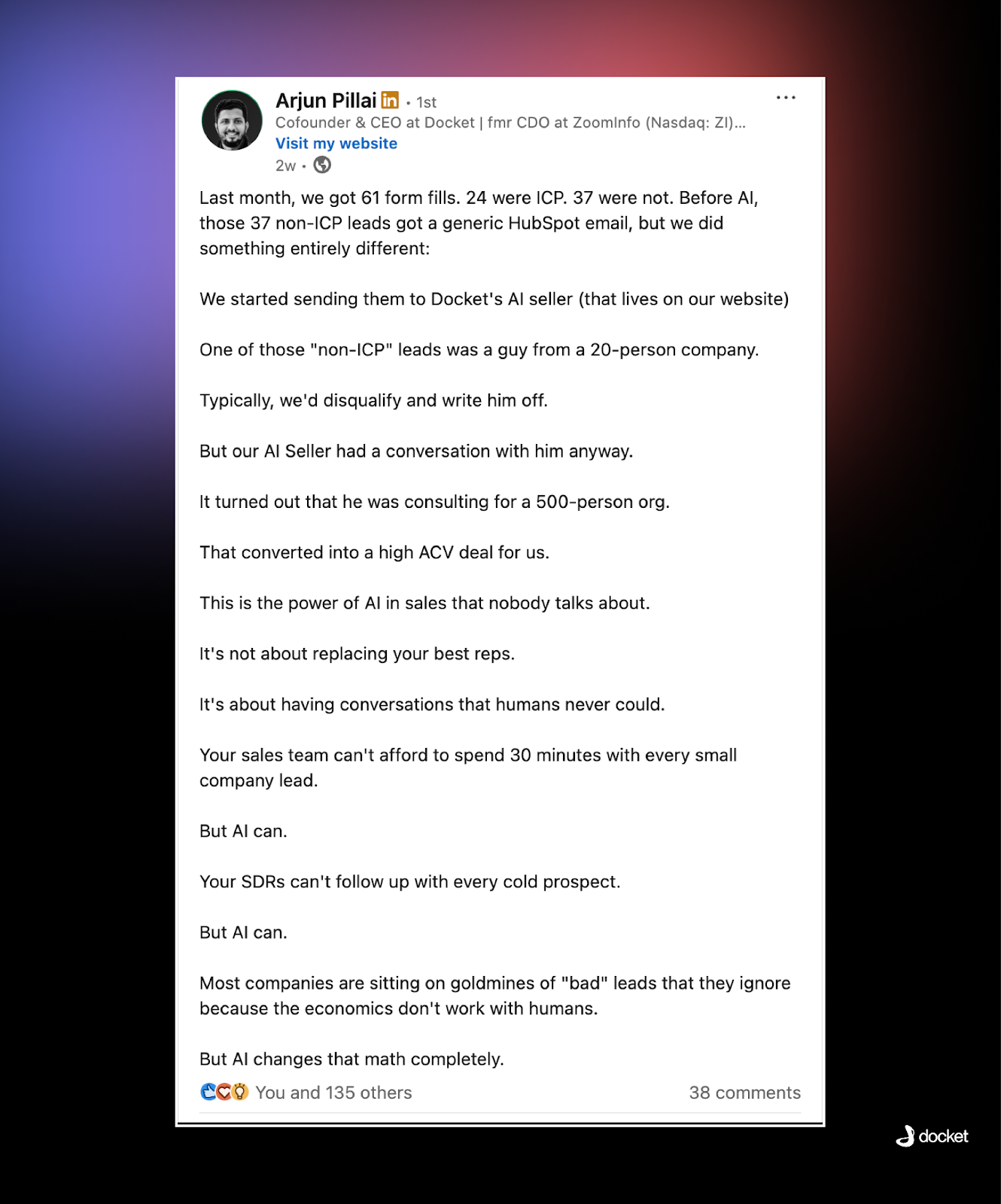
Here are more things we’ve seen our marketing agent impact directly
- Faster pipeline velocity
Before agents:
Website visitor → form submission → SDR outreach → discovery call scheduling → demo booking (7-14 days)
With agents:
Website visitor → AI qualification → meeting booked with context (same day)
Impact:
10-15% faster deal cycles on average.
If you want concrete tactics to shave weeks off, you can start with this guide. We’ve explained 6 ways to shorten B2B sales cycles.
- Lower customer acquisition costs
Traditional lead-gen funnels leak prospects at every handoff, but an always-on autonomous agent plugs those leaks.
Cost reduction drivers:
- Eliminate SDR time spent on unqualified leads
- Reduce meeting no-show rates through better qualification
- Capture after-hours prospects who would otherwise bounce
- Scale qualified conversations without scaling headcount
- Answer queries of champions who are trying to sell your solution internally.
Impact:
Customers report a 15-30% reduction in cost per qualified lead.
- Revenue acceleration through 24/7 availability
B2B buyers research and evaluate solutions around the clock. This is also how you & I evaluate most products before we buy it.
I am researching a laptop I want to buy at 11 PM on a Saturday night.
A B2B leader you are trying to reach is browsing your website at 10 AM on a Sunday morning, when she actually has some downtime.
Most of your competition is sleeping when your prospects are doing these searches, but Docket’s marketing agent doesn't have to.
This guide explains how to keep reps effective in a 24/7, remote-first world without burning them out.
After-hours impact:
- A major percentage of qualified conversations happen outside business hours
- Weekend traffic also converts much better when agents are active
- International prospects get immediate responses regardless of time zones
Docket runs 24/7 by design, so late-night and weekend traffic gets instant, qualified responses instead of bouncing.
How does your website Chatbot set you up for the future of Agentic Marketing?
Don’t think about your website chatbot as just a lead-gen tool. Instead, it's your entry point into the future of autonomous marketing.
What is agentic marketing?
Agentic marketing deploys AI agents that observe, reason, plan, and act toward business goals without constant human intervention. Unlike traditional automation that follows predetermined workflows, agentic systems adapt strategies dynamically based on real-time data and outcomes.
Think of it this way: Instead of building complex email sequences, you tell an agent to "grow pipeline by 15%" and it figures out the optimal mix of content, outreach, ad spend, and timing to achieve that goal.
For a deeper dive, read our guid, which explains how agentic marketing runs across different channels
Autonomy starts in chat
Your website chatbot represents the first proof point of an actual marketing agent in action.
Why chatbots are the perfect starting point:
- Real-time decision making: Every prospect interaction requires contextual judgment calls
- Goal-oriented behavior: The agent pursues qualified meetings, not just responses
- Multi-system orchestration: Integrates CRM, calendar, email, and analytics seamlessly
- Measurable outcomes: Direct pipeline attribution validates the agentic approach
A 24/7 chatbot that greets, qualifies, and books demos demonstrates that AI can own complete business processes autonomously.
We don’t like to toot our own horn, but Docket’s marketing agent is a good example of Agentic Marketing
Docket's AI agent demonstrates agentic marketing principles in action:
- Observes: Tracks visitor behavior, company profile, and engagement patterns
- Reasons: Understands context, intent, and optimal conversation pathways
- Plans: Develops personalized qualification and conversion strategies
- Acts: Engages prospects, books meetings, and updates systems autonomously
Results: Customers experience 10-15% shorter sales cycles and 15% more qualified pipeline without human intervention.
Goal-based vs. workflow-based marketing
Traditional marketing automation chains together predetermined actions: If email opened → wait 3 days → send follow-up → if clicked → alert sales
Agentic marketing sets objectives and lets AI determine the path: "Convert 100 enterprise prospects this quarter" → Agent analyzes data, tests channels, personalizes outreach, and optimizes in real-time
The fundamental shift: From designing journeys to defining destinations.
If you’re exploring GenAI’s impact on enablement and forecasting, this primer is a good place to start.
Future-ready metrics for autonomous systems
As your chatbot evolves into a complete agentic marketing system, you'll also track new performance indicators.
Autonomous Conversion Lift (ACL): Revenue generated directly by agent-initiated actions without human triggers
Time-to-Insight (TTI): How quickly agents detect and act on new behavioral signals or market changes
Multi-Agent Collaboration Efficiency: How well your chatbot agent coordinates with email agents, ad agents, and content agents
Goal Achievement Rate: Percentage of business objectives met through autonomous agent orchestration
Where does Docket fit?
Every step in modernizing your lead-gen flow maps directly to Docket's core capabilities:
Step 1: Page mapping → Docket's behavioral analytics
Docket automatically identifies high-intent visitor patterns and content gaps through real-time engagement tracking.
Step 2: Knowledge centralization → Sales Knowledge Lake™
Docket's proprietary Sales Knowledge Lake™ unifies scattered go-to-market knowledge from 100+ integrations into a single, searchable graph that learns from your best sales conversations.
More on why we think knowledge availability is the #1 unlock for improving conversion.
Step 3: Agent deployment → Autonomous Conversational Agent
Docket's AI agent handles substantive sales conversations, provides detailed product demonstrations with visuals, and qualifies prospects using the same discovery framework your top reps use.
Step 4: Intent data optimization → Progressive profiling
Every Docket conversation builds buyer context. When prospects return, the agent remembers previous discussions and asks increasingly sophisticated questions to refine qualification accuracy.
The agentic leap → Goal-based orchestration
Docket agents don't just respond to prospects—they pursue revenue outcomes. Set a goal like "book 20 qualified demos this month" and Docket adjusts its qualification criteria, conversation pathways, and follow-up timing to hit that target.
Here is Docket’s implementation advantage
While competitors require 6-month implementations and extensive training, Docket deploys in 1-2 weeks with SOC-2 compliance built in.
Key differentiators:
- Sales depth: Trained on B2B sales methodologies, not generic customer service
- Autonomous qualification: Doesn't just route, but qualifies using BANT, MEDDIC, or your custom criteria
- Revenue focus: Optimizes for pipeline generation & not just chat volume
- Scalable intelligence: Gets smarter with every conversation without manual training
An example what 15% more pipeline looks like?
Company: Mid-market MarTech SaaS (500 employees)
Challenge: Website converting only 0.8% of visitors despite high-intent traffic
Timeline: 90-day deployment and optimization
Before Docket
- 12,000 monthly website visitors
- 96 monthly form submissions (0.8% conversion)
- 48 qualified leads after SDR review (50% qualification rate)
- 12 booked demos (25% booking rate)
- Average response time: 8 hours
- Weekend/after-hours prospects: Lost
After Docket
- Same 12,000 monthly website visitors
- 187 monthly qualified conversations (1.56% engagement rate)
- 149 qualified leads (80% qualification accuracy)
- 89 booked demos (60% booking rate)
- Average response time: Instant
- 24/7 availability captured an additional 34 qualified prospects
The math
Pipeline increase: From 12 to 89 monthly demos = 641% improvement
Quality improvement: Qualification accuracy jumped from 50% to 80%
Efficiency gain: Zero additional SDR time required
After-hours capture: 34 additional monthly prospects (28% lift)
Want to see how this will affect your website conversion and pipeline? Request a Docket walkthrough and we’ll show a custom walkthrough for you right away.
If you also want to add a bit of personalisation to compound these numbers, check out this guide.
FAQs about Docket & lead gen chatbots
Will this replace our SDR team?
No. Autonomous agents augment SDRs by handling initial qualification and routing only sales-ready prospects. Your SDR team focuses on high-value activities like account research, personalized outreach, and complex deal navigation.
If a company promises to replace your entire SDR team, you should probably run in the other direction.
Real impact:
Teams typically redeploy 40-60% of SDR time from qualification to revenue-generating activities.
What about data security and compliance?"
Enterprise-grade autonomous agents are built with a security-first architecture. Docket maintains SOC-2 Type II, GDPR, and ISO 27001 certifications with role-based access controls and complete audit trails.
Key safeguards:
- No training on customer data
- Complete data deletion upon contract termination
- Encrypted data transmission and storage
- Configurable retention policies
How do you prevent the agent from going off-brand?"
Modern AI agents operate within defined guardrails that prevent off-topic responses or brand inconsistencies.
Docket's approach:
- Brand voice training on approved messaging frameworks
- Industry-specific response boundaries and real-time human oversight capabilities
- Conversation escalation protocols for complex scenarios
What's the integration overhead?"
Best-in-class solutions integrate with existing tech stacks through pre-built connectors, not custom development.
Typical integration timeline:
- Week 1: CRM and calendar sync
- Week 2: Knowledge base connection and testing
- Ongoing: API connections as needed
Docket advantage: 100+ pre-built integrations with major CRM, marketing, and sales tools.
How do I measure the ROI of a lead generation chatbot?
You can track autonomous agent performance using both traditional metrics and new agentic KPIs:
Traditional metrics:
- Conversion rate improvement
- Cost per qualified lead
- Sales cycle acceleration
- Pipeline attribution
Agentic metrics:
- Autonomous conversion lift (ACL)
- 24/7 engagement capture rate
- Qualification accuracy vs. human baseline
- Time-to-meeting booking
Expected ROI timeline: Most customers see positive ROI within 60-90 days of deployment.
If you want a ready-made scorecard, feel free to start with these 20 pipeline metrics.
Next steps when you are ready to fix your funnel?
Lead-gen chatbots built on rigid decision trees are killing your pipeline conversion. Autonomous AI agents that understand context, qualify prospects intelligently, and book meetings around the clock represent the future of B2B lead generation.
The opportunity is massive: capture the 98% of website visitors who currently browse and bounce, accelerate pipeline velocity by 10-15%, and build the foundation for fully agentic marketing systems.
The quickest way is a Docket demo, which you can experience on our website here. See how our marketing agent answers ll your questions, qualifies you, and books a demo with us in minutes.
Here are some related reads to expand your thinking
- What is Agentic Marketing and why is it the future?
- 20 pipeline metrics for CMOs and marketing leaders in 2025
- 7 ways to solve slow lead-response time for B2B companies
- Key takeaways from the Docket + Sybil SaaStr dinner


